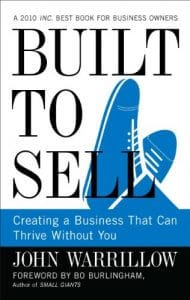It’s great to be here and chat with you.
I’ve been on your show talking about getting acquired and how that all panned out and some of the lessons I learned, which some were painful. Let’s talk about lessons learned. What have been some of the most powerful lessons that either you’ve learned from buying/selling businesses or some of your guests have learned and/or some of the people that you’ve interviewed for your book?
As you know, I do this podcast called Built To Sell Radio where we interview entrepreneurs who have recently sold their company. One of the big lessons might be the need to create competitive tension when you go to sell your company. When you sell your company, having competing offers is what’s going to drive not only the sale price up but also the deal terms that you get. A lot of business owners get wooed by a single acquirer and think they’re best friends with that acquirer. The acquirer is trying to act friendly in an effort to get you to sell them their business at a price that’s oftentimes lower than it’s worth. That’s a theme we keep seeing coming up again and again where acquirers have to ingratiate themselves with owners. Owners say, “All these guys are great. I don’t want to create a competitive auction,” and they get taken advantage of as a result of that. That’s one of the themes but there are probably dozens more I could think about if you give me time.

Let’s go a little bit deeper into that. Let’s say that you get an offer and you weren’t even thinking about selling at the moment. Now what? Do I get the word out? Will that freak out the potential acquirer? Even if I didn’t get any offers I’m like, “I want to get the word out so that people will start giving me offers,” how do I do that in a way that doesn’t make us look like it’s a fire sale?
I would first of all always be cultivating a half-dozen relationships with people that you think would have an interest in potentially acquiring your company at some point. These may be people that you meet in a trade show and people that you meet in your industry, that you think they would probably be a good acquirer for us one day. Try to create a relationship with them, checking with them every six months. Keep things on a relatively open dialogue and then when you get that unsolicited offer, you can reach out to them relatively quickly because you know who they are and say, “We have this unsolicited offer. It looks pretty attractive. I’m going to go down the route of exploring this unless you had any interest in potentially partnering with us. Let me know.” It’s not the same thing as a formal auction where you would put a book together and formally take your business to market. It is reaching out, creating some potential demand or some potential competition for your business. That’s a very low-key way to do it if you get an unsolicited offer.
Most owners would take a slightly more proactive approach where they hire an M&A professional or business broker and they go through a process. These guys have a formula that they go through but they try to figure out who’s most likely to buy your business. They have a whole process that they go to market your business to those individuals. That’s probably the proactive way to create some competitive tension. Since you asked about what if you get an unsolicited offer? That’s a way to even deal with the unsolicited offer. A lot of unsolicited offers are fishing exercises. They’re not serious offers, they’re fishing attempts to get you to react and potentially you sell your business for a lot less than it’s probably worth.
Or to steal your IP. I know somebody who got screwed over in that way. It was a fishing expedition and they opened the kimono, “This is all of our IP. These are the patents that we’re applying for and the technology.” They’ve created a competing technology and stole what they were doing. They didn’t buy the company. This competitor ripped off their IP and then filed a patent in Europe where they hadn’t thought to file a patent yet, they were working on getting a patent in the US. They’ve filed a lawsuit for patent infringement because they got the European patent before the company that originated this stuff and open their kimono. It’s evil.
There are lots of stories like that where the acquirer is disingenuous in their attempts to get you to sell them their company. They’re doing it for ulterior motives. I remember I did one episode of Built to Sell Radio with a guy, he came up with a cure for female baldness; thinning of the hair among women. Alopecia is a real thing and what he came up with works. To the best of my knowledge and certainly through lots of clinical trials, it did improve outcomes for patients. We were talking about this exact thing. How do you protect the IP because it’s the secret? Once you know the formula, you don’t need that to buy the business, you can rip off the formula and compete with them.
Value building is, in many cases, the opposite of chasing top-line revenue growth. Share on XThis was hundreds of millions of dollars the company was getting acquired for, it was a huge deal. He said to me, “Through the diligence process, you’re parsing out information on a need-to-know basis slowly. You’re dripping information, financials, projections,” but he said, “Never ever during the diligence process did I reveal the secret sauce.” That’s only handed over upon the actual share purchase agreement being signed and the check is cleared and the wire transfer is complete. For a website company, that might be the code behind the actual website. For a product company, it might be the actual formula that you generate your products by, but some things you never reveal in the sale process of selling your company until it’s sold.
You might have a separate company holding the IP. I have a separate IP company, it’s a C-corp. I have my operating company which is an LLC. My business is an SEO consultancy and the operating company, the LLC is doing the consulting work for companies like Volvo and so forth. The IP company is what holds all the IP and licenses to the operating company. Let’s say that somebody tries to come after me with a frivolous lawsuit or something, they would come after the operating company and not the IP company. That’s very protected with an additional layer. Is that typical that you find or is that more unusual? I think it’s the best practice but I don’t know that a lot of people are doing it.
I wouldn’t say that’s typical. It’s good for planning and asset protection on your behalf. Oftentimes people will do similar things with buildings. If they own the building, they operate the building in a separate company and they lease it to the operating company. Those are common set-ups. The other thing it does remind me of is the difference between selling your shares and selling your assets. When you go to sell your company, it’s either going to be a share deal or an asset deal. An asset deal is where they’re essentially buying the assets of your business but they’re not taking on your company’s legal obligations. They’re not taking over the shares of your company. Whereas if you sell the shares, they’re taking over the operating company as well as its obligations. Why does this matter? It matters because if your company has potential legal threats looming in the bushes and an acquirer buys your shares, the acquirer will assume those responsibilities.

If you’ve got a disgruntled employee as an example and you get acquired by Google, that disgruntled employee may say, “Stephan is not worth going after,” but all of a sudden Google is the owner. They file a wrongful dismissal case and it’s a huge knot because they know Google’s got the money to pay. That’s why big companies typically want to buy your assets and you as a founder may want to sell your shares. There are also tactical implications and different jurisdictions to think about. It’s getting into the weeds of this topic but it’s important to think through, are you selling your assets or are you selling your shares?
Also, what’s your structure because I had my previous agency which was an SEO agency, Netconcepts, it was an LLC. The company that acquired my company was a C-corp. It was Covario and I paid a lot of money in additional tax that I didn’t have to if they were also LLC or if I were also a C-corp. In hindsight, it’s 20/20 but you’ve got an acquirer who wants to buy you and the terms are favorable. It’s a strategic fit and all that so you want to do the deal. The fact that it’s the wrong business structure, you’re going to pay hundreds of thousands of dollars more money or more is an unfortunate oversight.
It comes down to a frictional cost of selling. Some of the other frictional costs, you typically would have to pay your adviser, your M&A person, on a deal of in excess of $10 million for example. Usually it’s somewhere between 3% and 5% that you would pay to your M&A professional to represent you. On a smaller business like $1 million company or $2 million company, it’s usually 10% on the first million, 8% on the second million and then so forth. There’s that sales cost and then there’s usually a legal fee. You might budget 2% to 4% of the overall deal for legals. It would be conservative and it gives you lots of room. You may want to pay some employees, some stay bonuses or Thank Yous for doing the deal. Then as to your point, there’s also a tax event that happens when you sell your company. All of these things are frictional and they do impact the overall net proceeds. You want to think about selling on a net basis like, “What do I leave with?”
One other thing, and I don’t know in your case if this happened to you. There are two big swing factors. One is your employment agreement. A lot of owners disregard their employment agreement. They’re like, “I’m selling my company. The acquirer wants me to work for them for a year or two, but I don’t care.” That’s a huge mistake because there’s a lot of money on the table in employment agreements, in particular around severance and the implication of if the acquirer itself gets acquired, what happens then? There’s a lot to be done in negotiating your employment agreement. A lot of money to be made or lost in that.
The other one that we get a lot of is the working capital calculation. This is the amount of money that you need to leave in the company essentially when you hand over the keys. A lot of entrepreneurs think their retained earnings are theirs and a lot of buyers think they’re buying the company including any money in the bank, which is in the form of retained earnings. Getting that upfront, being clear on what the working capital calculation is, can have a swing factor on your net proceeds by hundreds of thousands or millions of dollars in some cases. Did you guys work through working capital? Was that a deal factor in your deal?
I don’t recall. I had an interim CEO that I hired to help facilitate the transaction. We didn’t use an M&A professional but we had an interim CEO who was familiar with getting acquired. I didn’t get into all of the weeds. I got into a lot of them because it was my company, I wanted to make sure that everything was hunky-dory from my standpoint, but the working capital thing I don’t know. To your first point about the employment agreement, that I was very diligent about because I did not want to be stuck with golden handcuffs for two years. That was not acceptable to me. I negotiated down the earn-out to be six months.
It was focused around retaining a certain core set of clients and their revenues, which made sense that they would expect that those clients would not just up and leave as soon as the acquisition happened. I made sure that they stayed and I got my earn-out. Then right after the check cleared, I’m out the door. Funny enough they were surprised like, “Really? I’m unemployable. I’m not going to work for anybody.” Did you sell your own business at some point or did you get into this by being a broker or helping friends get their businesses sold? How did this come about for you?

To be clear, I’m not a broker or an M&A professional. I run a company called Value Builder where we help entrepreneurs improve their value leading up to an exit. I got into that business having been involved in four startups myself, exiting them, I learned a lot of lessons along the way. I wrote a book called Built To Sell, which is an amalgam of those lessons. That’s what inspired the company Value Builder and why we’re here talking about it.
When somebody is involved with your Value Builder System, are they trying to increase the multiple or somebody might value their business at when they go to get acquired?
That’s exactly right. We’ve had 40,000 customers over the years and business owners that start with us on average get a Value Builder score of 59 out of the possible 100. We have them take this questionnaire and the average is 59 out of the possible 100. Those businesses are trading at 3.5 times earnings. It’s a relatively low multiple. We have a group of our all-star clients who achieved a Value Builder score of 90 or more out of the possible 100. Those businesses are trading at 7.1 times pre-tax profit. More than double the average business. We’ve got this whole process, this twelve-step thing that business owners can walk through to help them improve their value and it’s working. It’s what we do.
What are the twelve steps?
We don’t have time to go through all but I can give you a sense. There are eight key-drivers of your company’s value, which roll up to twelve steps. Some of the drivers require two steps to work through. The drivers would be first of all the financial performance of your company. How much revenue you generate, how much profit you make, the efficacy of your bookkeeping is all under the financial performance section. The growth potential of your business. What it’s likely to do in the future. Remember the acquirer is starting their race. You may feel like you’re finishing a marathon and selling your company but they’re just starting, so they want to know what the future is. That’s growth potential.
The Switzerland Structure is your dependence on any one, customer, employee or supplier. You’ve got to minimize your dependence on any of those three. Hub and Spoke is the dependence that your company has on you personally. The Valuation Teeter-Totter relates to cashflow and is distinct and unique from financial performance. Cashflow is literally cash coming in and out of your company. Recurring Revenue is important for maximizing the value of your company. Those are the eight key-drivers that make up the system. We’ve got twelve tools that help clients think through how to improve their score in each of those attributes.
Revenue is vanity; value is sanity. Share on XCan we pick one of the twelve and have a peek inside the system?
Recurring Revenue is a topic that always is hotly debated and is lots of fun to talk about.
What would be one of the tools for improving that?
There are two modules or two tools that sit under there. One is called the Automatic Customer Builder. The Automatic Customer Builder is like a walk through a wizard. It prompts you with a set of questions about your company. Are you selling to consumers or other businesses? Do you have thousands of customers or dozens of customers? Are you local, national or international? There’s a whole list of questions that we ask. In prompting those answers or responding to those questions with answers, it will eventually get to a point where it recommends one of the nine recurring revenue models for your business.
We’ve identified that there are nine recurring revenue models for any business. They go beyond Software as a Service. When I say recurring revenue, most people think of two things. They think of SaaS, Software as a Service or they think of media like magazines, newspapers, that kind of thing. The Automatic Customer Builder, the intent of the tool is to say no matter what industry you’re in, whether you’re a carpet cleaning company, a retail store, a wholesaler or a service company, you can create some recurring revenue. The Automatic Customer Builder prompts you this set of questions and then it gives you which of the nine recurring revenue models is most likely to be a fit for your industry.
Let me jump in here and ask you for a hypothetical here. Let’s say that it’s a service company and it’s consulting. I’m a consultant, SEO consulting, let’s use that as a hypothetical. What would be the recurring revenue model that wouldn’t involve creating online courses and not a membership site? It’s a service-based business, SEO audits and keyword strategies, link building strategies are the typical deliverables. A client will typically feel like, “I’ve gotten all these strategic deliverables. This is my roadmap. I’m good. I’ve got my internal team. They know what to do. You’ve explained all the recommendations and all the findings sufficiently. We’re ready to rock and thank you, have a great life.”
What we would do to create a recurring revenue model for SEO are a couple of things. What you want to do is look at your customers and start to segment them. My guess is that you’ve got some customers that are small businesses, other companies are mid-sized, large organizations potentially. You mentioned Volvo, so you probably got everyone from Volvo down to more startup businesses. Would that be fair?

Startups can’t afford me, my retainers start at $15,000 a month so that’s not for everybody but a smaller business that might be $1 million or $2 million in revenue. It might be a smaller size business.
The first thing you want to do is start to segment your customers and try to figure out what they need on a recurring basis. I don’t know your industry, I don’t know your business well but one of the recurring revenue models which is a membership website where you could potentially provide access to proprietary SEO information on a recurring basis. It’s stuff that changes like Google’s app Black-Box, algorithm changes, they need updates, so you could offer behind a paywall to do that. You could also offer roundtable groups, mastermind groups to non-competitive organizations that have an interest in SEO. You can have the head of SEO marketing or the head of the digital strategy for Volvo, Procter & Gamble, IBM and Walmart.
The other thing you could do is provide, on an ongoing basis, benchmarking data. Benchmarking data is a great way to create a recurring revenue model. If things change, how a website indexes to various keywords is something that changes all the time. As people optimize their site against your site, as Volvo optimizes for Tesla, it changes always as you know as the algorithm changes. Being able to show a client on an ongoing recurring contract basis that you’re benchmarking their performance. You might say, “Why would you want to do that? What’s the point?” There’s this thing called the Trojan Horse effect. What it states is that once someone becomes a subscriber, it makes them much more likely to buy your other stuff. Let’s say you do a project for Volvo and you charge them $200,000 to optimize Volvo’s website. They say, “Thanks, Stephan. Great job.” You may want to sell them a benchmarking contract where for $500 a month, you’re going to send them a report, which gives them how they’re ranking on various keywords that are important to them on a real-time basis every month.
You might say, “Why would I care about $500 a month when I’m selling Volvo $200,000 worth of SEO?” The reason you care about the $500 a month is that it makes Volvo infinitely more likely to hire you again and to use your other services, i.e. your consulting services. Once somebody subscribes, it makes them way more likely to buy again from you. Amazon as an example has Amazon Prime. Typical Amazon customer spends about $600 a year with Amazon. Typical Prime subscriber will spend $1,500 a year or 3x that of the average non-Prime customer. They get free shipping for sure, but Amazon also has your credit card. They have your address. They have permission to communicate with you through email. It makes it way easier for you to create an ongoing relationship with someone. You’ve already got an open PO with Volvo in case of an enterprise organization. You’ve already gone through their compliance hurdles. They’ve validated you as an approved vendor. All of these things make it frictionless to continue to use you. Anyway, that’s SEO. There are nine models but that’s just a couple of examples of how you might create some recurring revenue in SEO consulting.

If somebody is interested in working through your Value Builder System and optimizing to go from let’s say a 59 score to a 90, what does that process look like? What’s the investment? What’s the timeframe that it typically takes?
The first step is to go to ValueBuilder.com and complete your Value Builder questionnaire. It’s free and we give you a score instantly. From there, we’ll put you in touch with one of our certified Value Builders who are trained in our methodology. We have 900 of them around the world, depending on where you are. Chances are if you’re in the English-speaking world, somewhere in the United States, Canada, Australia, South Africa, will be able to find you a highly qualified certified Value Builder who will walk you through our system, our process.
Are these brokers and M&A professionals? Are they business coaches who have been trained in your methodology?
Everybody has been trained in our methodology but they would be advisers. They would typically be M&A professionals, consulting companies, accounting firms who are trained in the methodology. The cost would depend on how much of their time you need, how many years you want to commit to building for value. We believe that it’s a long-term process. Getting from a 59 to a 90 on Value Builder could take multiple years. It’s not a fast-quick process but it’s huge. Think about a business generating $1 million in profit at 3.5 times multiple is $3.5 million, a 7.1 multiple is $7.1 million. We’re talking about huge numbers here. It’s worth investing a year or two to move the needle.
It can be very rewarding to go back to being happy as opposed to rich or famous. Share on XEven if you’re not interested in selling your company, you’d get value out of this. I could imagine going through your methodology. You could maybe end up on the Inc. 500 list or at least the Inc. 5000 list if you apply. Then you get all sorts of kudos for having that badge and that honor that you get bestowed on you.
I wouldn’t say that you would likely get an Inc. 500 nomination because of Value Builder. Here’s the thing. There are lots of benefits going through Value Builder beyond selling your company. The peace of mind to know you’re building a valuable asset. Ten years from now, you want to sell, you’re building something. That you are much more likely to qualify for the bank financing investment that you’re interested in, and that peace of mind to know that you’re building a much more valuable company that’s not dependent on you. Here’s why I take issue a little bit with the Inc. 5000 reference. Value building is in many cases the opposite of chasing top line revenue growth. The Inc. 500 is the fastest growing company in the United States, and for a lot of them they subscribe to the idea of revenue is vanity. They puff out their chest and say, “We hit $10 million in revenue this year.” That’s how they are defining their success; how many employees they have, how many locations they have.
It’s a fool’s errand to think that way in my view because those companies oftentimes have had to dilute themselves, give or sell a truckload of equity in order to fuel that growth. They’ve had to take on all sorts of obligations. Our view is exactly that revenue is vanity. What really is the end of the second part of that expression is usually profit is sanity. In our case we change it to value is sanity. I would much rather own a $3 million business, generating $1 million in profit than being a 5% shareholder in a $20 million company that’s growing at 50% a year. That’s a trade-off. I wrote a blog post saying, “Would you rather be rich, happy or famous?” To go backward in that, famous is the Inc. 500 company. The fast growth venture-backed, except a lot of risk and dilution in order to be on the cover of Inc. Magazine. In many cases, the venture capitalist will take out the entrepreneur, bringing their equity down to single digits and in often cases, they’ll dilute them down to nothing. That’s a great way to get famous. It’s not necessarily a great way to get rich.
Happy is generally people who are mastering their craft. If you want to know who’s the happiest in the world of entrepreneurship, it’s often the people who have unsellable companies. It’s the guy who fixes guitars or teaches swimming lessons, where they love the actual craft of doing the work. They’re not necessarily building anything of any value. They essentially have a job, as Michael Gerber says, “They’re working in not on their business,” but they’re happy doing it. The richest people generally are the ones who find a quiet little niche, build a company that is highly profitable that is not very competitive with a lot of other people. By definition, to do that you’ve got to be in a sleepy little niche. You can’t be an AI or autonomous driving or search engine optimization. You have to be in a very small niche where nobody cares about it, but you go out and build a $3 million, $5 million, $10 million company, generate 20%, 30% margin because it’s in this very uncompetitive niche. That’s how you create incredible wealth because not only you’re pulling out money each year because you’ve got a positive cashflow cycle. You’re also building a sellable asset where you own 100% of it because you haven’t had to dilute yourself down to anything in order to fund your desire to be famous. Rich, happy or famous, you pick one.

Which one do you pick?
It’s for everybody to decide. I wrote a book called Built To Sell and I run a company called Value Builder. I believe that revenue is a bit of a vanity play. It makes people feel proud of themselves. In the end, they can be chasing a bit of a mirage, because in many cases those are the businesses that fail or become diluted so I’m not a fan of that model.
I agree revenue is a vanity metric or vanity play. I learned that the hard way unfortunately. I was focused on revenue and so were my other executives in my previous company, Netconcepts. That meant that I walked away with not nearly as much as I should have or could have. Now, with this business that I’ve been running since 2010, it’s all been about profit. Revenue is less than my previous agency, which wasn’t even just an agency. I should mention that too. We pivoted to becoming more of a Software as a Service company. Although we continue to hang our shingle out as an SEO agency. As prospects would come to us and say, “We want SEO consulting,” we would say, “We have a solution for you that is going to be perfect for you given how many months and how expensive it is going to be for you to implement all of our SEO recommendations. We have a Software as a Service and it will do an end run around all those technology hurdles.”
We charge on a cost-per-click basis. It’s pay-for-performance, we charged $0.15 a click and the technology relied on reverse proxy, so there was a proxy server. We made lots of money. We had Zappos using the technology and they’d pay us seven figures a year, which was unheard of at the time for a consultancy to earn that kind of money per client. The typical $10,000, maybe $15,000 price points for consulting but nowhere near what we were getting on a performance basis. That was pretty clever. If you can find ways to incorporate Software as a Service or some scalable technology into your offering, there is a lot of money to be had in that. That was very revenue focused. We kept reinvesting all that revenue into the growth of the company and I didn’t pay myself market rates and I didn’t maximize the profit. Instead, I was focused on the growth and I can see in retrospect how that was a vanity play. It worked out in the end but it could have worked out better for me personally if I had done something differently. Any thoughts on that?
You only get sell your company once and unless you’re a serial entrepreneur like Elon Musk, you probably only get one kick at the can or maybe two in your lifetime. We have dozens of opportunities to do all the other things that we do as entrepreneurs like negotiating a lease or hiring an employee or firing an employee or writing a marketing plan or building a cashflow spreadsheet. All these things we do dozens of times in our entrepreneurial careers. We only ever get a chance to do the sale maybe once, maybe twice if we’re lucky, but it can have a profound impact. In your case, there were lots of lessons learned.
In my case, the same thing. I learned a ton and inspired a lot of the work that we do now because I was like, “There isn’t enough information out there about the exit.” Usually, it’s veiled in all these confidentiality agreements, protected behind always so people can’t talk about it that much. It’s a very opaque market for selling smallish businesses. When Google buys YouTube, it’s a relatively transparent transaction because Google is a public company. They have to declare what they’re buying it for and their strategic intent, etc. None of that is true in the small business market. It’s this opaque, hard to understand, hard to know what the deal terms are. To some extent, we’re trying to make it more transparent. We’re trying to certainly help business owners have a fair shot at a good exit.
Speaking of transparency, I’m pretty transparent. One person who is incredibly transparent and is known for this is Rand Fishkin. I had him on this podcast talking about his building up of Moz and turning that into a $30 million business but with the help of venture capital and how he felt like he sold his soul to do it and the painful lessons he learned. Now he’s not even working at Moz anymore. He’s got another startup because it didn’t work for him.
Not an unfamiliar story to me. I heard it again and again. Did he make any money off the deal or did they dilute him or is he still holding the shares?

He’s still holding the shares. Going back to your blog post, he essentially took the get famous route. He’s famous, he’s a well-known SEO industry figure. Rand is also my co-author in the first two editions of The Art of SEO. You also mentioned Michael Gerber and this entrepreneurial delusion that we have that we’re building a business when we are just creating a job for ourselves, self-employment, because we haven’t built an asset. We’ve built something that just employs us and gives us terrible hours, terrible work conditions. We’re just wedded to the job more so than if we were working for somebody else. Oftentimes, it doesn’t pay even market rates. It’s pretty crazy to do that and yet so many of us do it. I interviewed Michael Gerber on the show as well. Any additional thoughts about Michael Gerber’s approach. The whole E-Myth book and anything like that?
It continues to be the quintessential small business owner’s manual, essential reading for any startup. One of the core ideas in Michael Gerber’s work is the idea of working on not in your business. Somebody who works on their business is focused on the strategy and then working in it is doing the work. When we think about companies that are built to sell and not dependent on the owner, it’s companies where the owner is not doing the work. It’s a good thought experiment to think through your endgame because it can help solidify what you’re doing and allow you to know whether you’re doing the right things. I did this speech to the Remodelers Association of America. These are people who do home remodeling. You’re putting in extra bedroom on your house, kitchen renovation, etc. There were 600 entrepreneurs in that room but most of them are working in, not on their business. Most of them are doing the construction as well as owning the company.
I get up there and I’m talking about all the stuff I usually talk about; the importance of recurring revenue, the importance of building a business that’s not dependent on you. One guy raised his hand and says, “You’re talking about making the Model T Ford of home renovation and we build hot rods. I have no interest in making my company the Model T Ford of the home renovation business. I get a kick out of building hot rods.” The audience went quiet and was like, “This is going to be a full-on fist fight between the two guys.” I responded by saying, “That’s totally fine as long as you know that in the end, there is no pot of gold at the end of the rainbow. As long as you know that you’re taking out profit along the way. Don’t be left delusional to the idea that you are going to sell that company. You can build the most beautiful custom hot rods and it can be very rewarding to go back to being happy as opposed to rich or famous, but there’s no golden pot at the end of the rainbow. Just know that.” We had a bit of a back and forth around that idea and that was fine for him. I would say the same thing if you want to be a practitioner, if you want to be an SEO consultant as opposed to running an SEO company, it’s totally fine but just know that there’s very little equity transferable value you’re building. You’ve got to make sure you’re scraping out the profits each year and getting paid for your time fairly that way.
I made this mistake early on in my first business. I tried to sell in almost 2000, 1999 timeframe. I got this crazy idea to move halfway around the world and live in New Zealand. I’d never been there and I applied for residency and got in. I was like, “I want to move to New Zealand.” I convinced my wife at the time and my kids and we’re all on board on doing that, but I thought a US-based business is not going to survive with the founder moving halfway around the world so I should sell it. Nobody would buy it. Nobody was interested because I was too intertwined in the business. I was the business and nobody wanted to buy the business without me. The founder is moving halfway around the world. How does that work? I couldn’t sell the business, which ended up being a blessing because I was able to massively grow that company. Even though as a US-based business, we already had momentum. We had clients like Birds Eye at the time, some big brands in the first four years. This was 1999. It’s very early days.
The happiest in the world of entrepreneurship are often the people who have unsellable companies. Share on XI was able to hire some great talents in New Zealand. We set up an office, a block from the beach and we had top people working on US-based projects. I paid maybe half or a third of what I would normally pay in the US, especially in Silicon Valley. It was amazing to get top-notch talent for such a low price. The conversion rate between the US dollar and New Zealand dollar was favorable at the time, it was good times. I was in New Zealand for almost eight years and still running the US-based company. I had a team in both places, in New Zealand and in the US. It all worked out but it was a lesson. I would not make that mistake again to be intertwining my personal brand and my company if I have any intention of selling that company later on. I want to mention the get famous route and Rand Fishkin. He’s got a great book that our audience should check out too. It’s a tell-all tale about his journey and the painful lessons he learned working with the VC community. It’s called Lost and Founder. It’s good. How do we hire a broker if we are on the stage where we want to explore our options for selling? Do we need a broker, first off? How do we know we’re hiring somebody good? What are the criteria, in other words?
I would definitely recommend having an intermediary. You wouldn’t sell your house without a broker, most people wouldn’t. I think that an intermediary, be it a broker or M&A professional, allows you to create competitive tension for your deal. It allows you to keep focused on your company while you’re selling it. One of the biggest reasons companies don’t sell is the business starts to suffer while the founders focus on selling it. M&A professionals are worth their weight. There are probably three types of brokers/M&A professionals that you might think about engaging based on the size of your company. If your company is less than $1 million in revenue, you’re going to be best served by a main street business broker.
If your company is between $1 million and $10 million, you’re in a no man’s land. You’re a little bit big for the main street business broker. You’re also a little bit small for the traditional M&A professional. That’s where finding a quality business broker or a lower-end middle market M&A professional is going to be important. If your business has $10 million or more in value, you’re going to be better served by an M&A professional, a mergers and acquisitions professional. Typically mergers and acquisitions professionals have an industry focus although not always, but oftentimes they do. You’re going to want to find someone, if you’ve got a larger business that’s in your industry, that’s got some experience in your industry. Business brokers are a little bit less likely to specialize in a specific industry. What you’re looking for is someone who understands your industry and understands your business. You’re looking for a demonstration of what are the key drivers of value in your business. I’d probe a little bit around that and I think you’ll get a pretty good sense of whether they understand the unique attributes of your company compared to the other businesses that they’ve been involved in. That would be my advice.
Probably it would be a good advice to talk to a broker before you feel like you’re backed into a corner and you need to sell your business.
If you talk to intermediaries, M&A professionals and brokers and say, “What’s frustrating about working with business owners?” They’ll say, “They come to me way too late in the process. They come to me when they’re burnt out. They want to sell their business in 30 days. I can’t do anything with that.” It takes six months to a year to properly market a business for sale. I get it ready to go to market, go to a deal. You need time, it’s not a fast process. You want to build that relationship well before you’re ready to hit the exit button.
More generally, this advice can scale to just ask for investment or for lines of credit and so forth and explore options for selling your business when you don’t need to, when you don’t need it. It’s the best time to ask for money because then you’re going to get the highest valuation, assuming you get all your other ducks in order, like build out your high-value score in the Value Builder System. Speaking of which, what’s the URL for the Value Builder System and for your personal website if we wanted to send folks to you to work with you and work with your company and take their business to the next level or exit it?
It’s simply ValueBuilder.com.
Thank you, John. This was so much fun and so enlightening. I’m sure we’ve got lots of questions from the audience who are interested in taking their business to the next level or maybe building a business that has the ability to sell. For our audience who are interested in taking this to the next level, post a comment. There’s also the ability to leave an audio voicemail, which we might even use on the show. We’ll catch you on the next episode.
Links and Resources
- John Warrillow
- LinkedIn – John Warrillow
- Twitter – John Warrillow
- Youtube – John Warrillow
- Value Builder System
- Value Builder
- Built To Sell Radio
- Stephan Spencer – Built To Sell Radio episode
- Built To Sell
- The Automatic Customer
- The Art of SEO
- E-Myth
- Lost and Founder
- Rand Fishkin – previous episode
- Michael Gerber – previous episode
- Entrepreneurs: Happy, Rich or Famous? Pick One!











